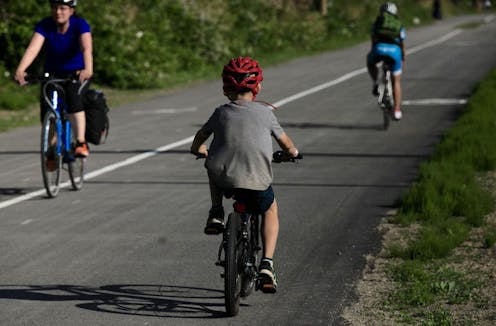
Cycling in Canada has been experiencing a great boom in recent years and a national map of cycling infrastructure is critical to allow Canadians to determine where they have access to safe and comfortable facilities and routes.
Yet, there has historically been no consistent and complete way to measure or communicate cycling infrastructure. Until now: Canada’s first national cycling map.
In 2019, we developed the Canadian Bikeway Comfort and Safety Classification system (Can-BICS) to classify cycling infrastructure by comfort and safety. Low comfort infrastructure is painted bike lanes, medium comfort is multi-use paths and high comfort are cycle tracks, bike-only paths, or local street bikeways.
We developed Can-BICS using the most current infrastructure design guides and cycling safety evidence. The same design guides are often used by city staff to develop cycling infrastructure.
The Can-BICS project not only provides a useful tool for Canadian cyclists, it also provides a clear window into the current state of Canadian cycling infrastructure.
How we built a national dataset
As researchers specializing in the links between the built environment and cycling, we often found ourselves piecing together datasets from different Canadian cities. Cycling infrastructure projects are typically co-ordinated by individual municipal or regional governments, with data held locally. For many projects, it’s too time consuming to compile data shared independently by multiple cities.
Another issue was that complete and up-to-date data are not even available for all municipalities in Canada.
While many larger cities may have staff dedicated to keeping their maps and databases up to date, other communities do not have the same capacity. Further complicating matters is the inconsistent use of terminology for bicycle facilities. For example, we found over 100 (often overlapping) terms in use in different cities across Canada.
And importantly, not all bike facilities are equal in comfort and safety. A national map needs to indicate different types of facilities, as not everyone is willing to cycle alongside motor vehicles.
To obtain infrastructure data that was consistent across Canada, we decided to use OpenStreetMap (OSM) — a crowdsourced map of the world. Like a Wikipedia for maps, OSM is constantly being updated and improved for accuracy for commercial interests and by data enthusiasts around the world.
We developed algorithms that apply the Can-BICS classification to the OSM data. Using Google Street View, we checked over two thousand reference points from OSM for classification accuracy and bias. These points were taken from five small, five medium and five large cities. We then used these algorithms to classify cycling infrastructure across Canada.
The result is the first-ever national dataset of cycling infrastructure in Canada.
Cycling infrastructure mapped across Canada
With the national dataset in place, we identified nearly 23,000 km of cycling infrastructure meeting Can-BICS standards across Canada.
However, over twice this distance (49,000 km) did not meet the safety and comfort standards. These might include gravel paths, suggested cycling routes, quiet residential streets with no specific cycling supports or sharrows on busy roads. (Sharrows are bike decals painted on the road surface to indicate that cycling is allowed, but there is no evidence that they improve safety or preference for cyclists.)
We found that in Canada, multi-use paths are the most common infrastructure type by length (16.6 per cent of all cycling infrastructure detected), followed by painted bike lanes (11 per cent). High-comfort infrastructure (cycle tracks, bike-only paths and local street bikeways) made up only 4.3 per cent of all detected cycling infrastructure.
Our results suggest that there is work to be done to support Canadians who are ready to make the switch to riding a bicycle. Cities aspire to meet climate goals and improve healthy transportation options for their residents. Yet, many Canadians are still without access to safe and comfortable options for cycling, especially in small- and medium-sized cities.
Harnessing data
The national cycling infrastructure dataset can support local, regional and federal governments in deciding where to invest in cycling infrastructure.
Read more: How to get more women on bikes? Better biking infrastructure, designed by women
The dataset is open for use by other researchers and planning practitioners interested in relating cycling infrastructure to other nationally available metrics such as census data. International researchers may be interested in our methodology to develop datasets of cycling infrastructure in their own jurisdictions.
We intend this dataset to become a reliable tool to facilitate comparison between cities. With the open code, it could be updated annually. This would allow users to monitor investments in high-quality cycling infrastructure over time.
Our work provides the first national map of cycling infrastructure available to Canadians. It allows researchers and practitioners to determine how individual infrastructure projects fit into the national landscape, determine gaps in the existing conditions and work to ensure safe and comfortable cycling is an option for all.
Meghan Winters has received funding from the Public Health Agency of Canada and Canadian Institutes of Health Research for this work.
Colin Ferster and Karen Laberee do not work for, consult, own shares in or receive funding from any company or organisation that would benefit from this article, and have disclosed no relevant affiliations beyond their academic appointment.
This article was originally published on The Conversation. Read the original article.







